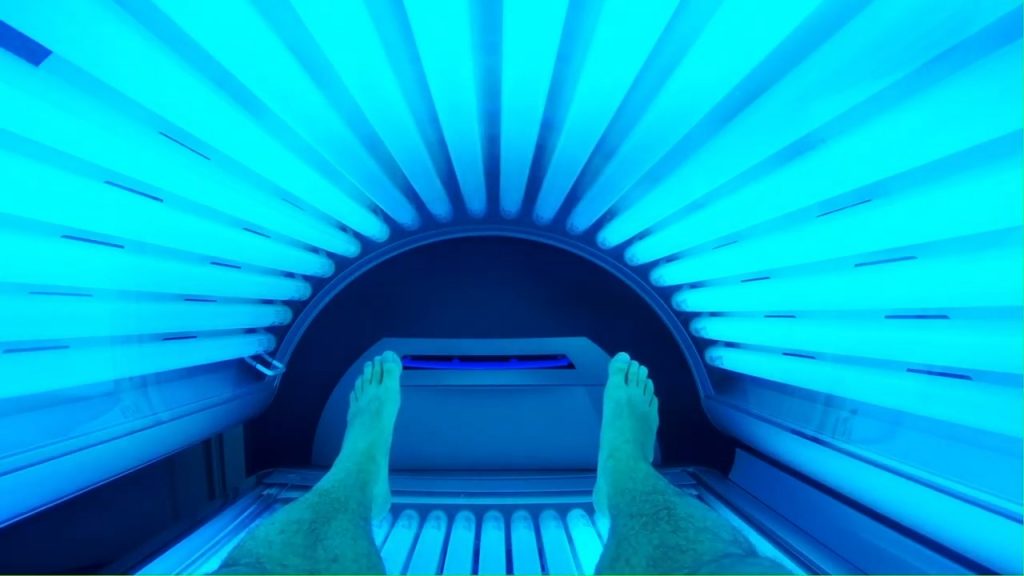Indoor tanning may seem unnecessary to some individuals as they can easily get a tan by exposing themselves to the sunlight outdoors. However, for individuals suffering from psoriasis, this may not always be feasible. In such cases, utilizing a tanning bed can provide significant benefits.
While the National Psoriasis Foundation cautions against using tanning beds as a treatment for psoriasis due to their predominantly UVA light emission which may not effectively clear the condition, they can still be useful for preparing the skin for sun exposure and providing other benefits. For instance, tanning beds can provide year-round relief for psoriasis symptoms, making them a valuable option for patients. By using tanning beds, individuals with psoriasis can reap the same benefits as sunlight, but in a controlled environment that minimizes the risk of overexposure to harmful UV rays.
If you are interested in learning more about how tanning beds can improve your psoriasis symptoms, then this article is perfect for you.

Tanning Beds Benefits for Psoriasis Symptoms
Tanning beds are one of the best solutions for improving psoriasis symptoms, and can offer significant benefits to those seeking relief from this condition, such as:
- Provide a controlled environment: Tanning beds allow psoriasis patients to regulate the amount of UV exposure they receive, minimizing the risk of overexposure that can occur when tanning outdoors.
- Improve psoriasis symptoms: Tanning beds can help alleviate symptoms of psoriasis, such as redness, itching, and scaling.
- Convenient all-year-round treatment option: Tanning beds offer a reliable treatment option for psoriasis patients who may not have access to natural sunlight, especially during the winter months.
- Boost Vitamin D production: Tanning beds help stimulate the production of Vitamin D in the body, which is essential for healthy skin.
- Enhance mental wellbeing: Psoriasis patients may experience a boost in mood and overall mental health from the warmth and light therapy provided by tanning beds.
Secondary Benefits of Tanning Beds for Psoriasis
- Boost Mood: Tanning beds provide regular UV exposure throughout the year, which can reduce mood disorders and depressive symptoms, making psoriasis patients feel better.
- Prepare Skin for Summer: A “base tan” from tanning beds during the early weeks of spring can help psoriasis patients prepare for the summer, when sun exposure can be harmful to their skin.
- Increase Vitamin D Levels: Tanning beds can stimulate the production of Vitamin D, which plays a huge role in skin health and in battling psoriasis.
- Relieves Pain: Tanning beds can ease stiffness, make muscles more flexible, and provide short-term pain relief, which can benefit psoriasis patients with psoriatic arthritis.
- Promote Weight Loss: Tanning beds can promote weight loss by increasing serotonin levels, which have an appetite-suppressing effect, and help psoriasis patients struggling with their weight.
- Boost Immune System: Regular use of tanning beds can boost the immune system by maintaining healthy Vitamin D levels and lowering inflammation, which is often unbalanced in psoriasis patients.
- Promote Bone Health: Tanning beds can promote better bone health by regulating calcium and phosphorus levels, which are important for bone growth and recovery.
- Reduce Heart Disease: Tanning beds can potentially reduce the risks of cardiovascular diseases, which is important for psoriasis patients who are at a higher risk of heart disease.
Tanning beds definitely offer many benefits for psoriasis patients by helping them manage their symptoms, improve their quality of life, and promote overall health and wellbeing.

How to Use Tanning Beds for Improving Psoriasis Symptoms
Before jumping straight to a tanning bed, there are some things you need to know before starting.
If you are considering using tanning beds to improve your psoriasis symptoms, here are some tips on how to use them safely and effectively:
- Start slowly: If you are new to tanning beds, start with short sessions and gradually increase the time as your skin gets used to the UV exposure. This will help prevent overexposure and potential skin damage.
- Use a moisturizer: Before and after each tanning session, apply a moisturizer to your skin to help prevent dryness and irritation.
- Protect your eyes: Wear protective goggles to shield your eyes from the UV rays.
- Don’t overdo it: While regular exposure to UV light can be beneficial for psoriasis, it’s important not to overdo it. Follow a schedule recommended by your doctor and don’t exceed the recommended time for each session.
- Take breaks: Allow your skin to rest and recover between tanning sessions. Taking a break for a few days or weeks can help prevent skin damage and reduce the risk of developing skin cancer.
Remember, while tanning beds can be a helpful tool in managing psoriasis symptoms, they should always be used safely and under the guidance of a healthcare professional.
Side Effects of Tanning Beds for Psoriasis Patients
While tanning beds can provide numerous benefits for psoriasis patients, it’s important to be aware of the potential side effects as well. Some possible side effects of tanning beds for psoriasis patients include:
- Skin damage: Overexposure to UV radiation can cause skin damage, including premature aging, wrinkles, and skin cancer. Psoriasis patients may be particularly susceptible to these risks due to their already sensitive skin.
- Eye damage: Exposure to UV radiation can also cause damage to the eyes, including cataracts and corneal burns. It’s important to wear protective eyewear while using a tanning bed.
- Irritation or worsening of psoriasis: In some cases, tanning beds can worsen psoriasis symptoms, causing redness, itching, and flaking. It’s important to start with short exposure times and gradually increase them to avoid this.
- Vitamin D toxicity: While tanning beds can help psoriasis patients increase their vitamin D levels, it’s important to avoid excessive exposure, as this can lead to vitamin D toxicity.
- Heat exhaustion or dehydration: Spending time in a tanning bed can cause the body to become overheated and dehydrated, particularly if the session is too long. It’s important to drink plenty of water and take breaks as needed to avoid these risks.
Who Should Not Use Tanning Beds
Although tanning beds can be a useful tool for some individuals, there are certain groups of people who should avoid using them altogether. Here are some examples:
- People with a history of skin cancer or other skin conditions. Tanning beds can increase the risk of developing skin cancer, so those with a history of the disease or other skin conditions should avoid them.
- Individuals with fair skin. People with fair skin are more susceptible to sunburn and skin damage, so they should avoid using tanning beds as they emit UV radiation that can damage the skin.
- Pregnant women. Pregnant women should avoid using tanning beds, especially during the first trimester, as the UV radiation can harm the developing fetus.
- Children and adolescents. The use of tanning beds is not recommended for children and adolescents as they have more delicate skin, which is more vulnerable to the effects of UV radiation.
- Individuals taking certain medications. Certain medications, such as antibiotics and acne medication, can increase sensitivity to UV radiation, making tanning beds a risky option for these individuals.
It is important to consult with a healthcare professional before using a tanning bed, especially if you have any underlying health conditions or concerns.
How Often Should You Use a Tanning Bed for Your Psoriasis?
For short but regular doses, 3 tanning sessions per week may be sufficient. Once desired results are achieved, 2 sessions per week can help maintain. When psoriasis symptoms are absent, rest the skin and use real sunlight while protecting against overexposure.
Is the UV light from tanning beds bad for psoriasis?
Benefits of UV exposure may outweigh the risks for some individuals with skin conditions like psoriasis or seasonal depression, as well as those with poor vitamin D3 absorption from supplements.
What type of tanning bed treatment is best for psoriasis?
UVB NB treatment, this is a medical treatment where patients are exposed to narrow band ultraviolet light in a sun booth under professional medical supervision.